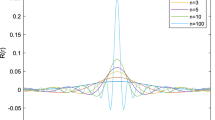Abstract
We propose to use the hyperspherical harmonics (HH) basis to solve the A-body system problem without explicit symmetrization or anti-symmetrization of the basis functions as required by the statistic of the system. Therefore, the HH basis set is expressed with respect to a given ordering of the A particles. However, after diagonalization, the eigenvectors reflect the symmetries of the Hamiltonian, and it is possible to identify the physical states having the expected symmetry under particle permutation. As an example we study the case of four particles interacting through a short-range spin-dependent interaction and the Coulomb potential.
Similar content being viewed by others
References
Fabrede la Ripelle, : The potential harmonic expansion method. Ann. Phys. (NY) 147, 281 (1983)
Novoselsky A., Katriel J.: Hyperspherical functions with arbitrary permutational symmetry. Phys. Rev A 49, 833 (1994)
Barnea N.: Hyperspherical functions with arbitrary permutational symmetry: Reverse construction. Phys. Rev. A 59, 1135 (1999)
Viviani M., Kievsky A., Rosati S.: Calculation of the α-particle ground state within the hyperspherical harmonic basis. Phys. Rev. C 71, 024006 (2005)
Gattobigio, M., Kievsky, A., Viviani, M., Barletta, P.: Harmonic hyperspherical basis for identical particles without permutational symmetry. Phys. Rev. [arXiv:0811.4259 physics] (accepted) (2009)
Varga K., Suzuki Y.: Precise solution of few-body problems with the stochastic variational method on a correlated Gaussian basis. Phys. Rev. C 52, 2885 (1995)
Timofeyuk N.K.: Shell model approach to construction of a hyperspherical basis for A identical particles: Application to hydrogen and helium isotopes. Phys. Rev. C 65, 064306 (2002)
Author information
Authors and Affiliations
Corresponding author
Additional information
Article based on the presentation by M. Gattobigio at the Fifth Workshop on Critical Stability, Erice, Sicily.
Rights and permissions
About this article
Cite this article
Gattobigio, M., Kievsky, A., Viviani, M. et al. Non-symmetrized Basis Function for Identical Particles. Few-Body Syst 45, 127–131 (2009). https://doi.org/10.1007/s00601-009-0045-4
Received:
Accepted:
Published:
Issue Date:
DOI: https://doi.org/10.1007/s00601-009-0045-4




